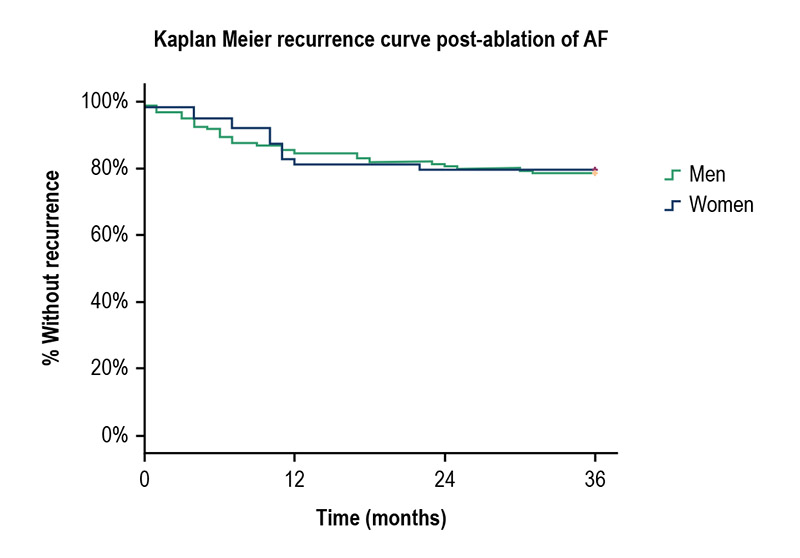Volume 110, Nº 5, May 2018
DOI: http://www.dx.doi.org/10.5935/abc.20180069
ORIGINAL ARTICLE
Paroxysmal Atrial Fibrillation in Females: Understanding Gender Differences
Gabriel Odozynski
Alexander Romeno Janner Dal Forno
Andrei Lewandowski
Hélcio Garcia Nascimento
André d'Avila

Figure 1 – Kaplan Meier curves for clinical recurrence post ablation by catheter categorized by gender; Log Rank test for trend comparison between groups (MxW) p-value = 0.89.
Abstract
Background: The catheter ablation of atrial fibrillation (AF) is performed less frequently in women. In addition, there is divergent information in the literature regarding the effectiveness and safety for the ablative procedure to females.
Objectives: The objective of this study was to compare the clinical characteristics and outcomes in men and women undergoing paroxysmal atrial fibrillation (PAF) ablation.
Methods: Cohort study of patients undergoing first-ever PAF catheter ablation procedure refractory to antiarrhythmic drugs. The information was taken from patients’ records by means of a digital collection instrument and indexed to an online database (Syscardio®). Clinical characteristics and procedures were compared between each gender (M x F), adopting a level of statistical significance of 5%. The primary endpoint associated with efficacy was freedom from atrial arrhythmia over the follow-up time.
Results: 225 patients were included in the study, 64 (29%) women and 161 (71%) men. Women presented more symptoms due to AF according to the CCS-SAF score (1.8 ± 0.8M x 2.3 ± 0.8F p = 0.02) and higher CHADS2 score compared to men (0.9 ± 0.8M x 1.2 ± 1F). Post-ablation recurrence occurred in 20% of the patients, with no difference based on gender (21% M x 20% F p = 0.52). The rate of complications was less than 3% for both groups (p = 0.98).
Conclusion: Women undergoing the first-ever PAF catheter ablation procedure present similar complication rate and clinical outcome compared to men. These findings suggest that the current underutilization of AF catheter ablation in women may represent a discrepancy in care. (Arq Bras Cardiol. 2018; 110(5):412-417)
Keywords: Arrhythmias,Cardiac; Atrial Fibrillation; Catheter Ablation; Cardiac Electrophysiology; Gender.















